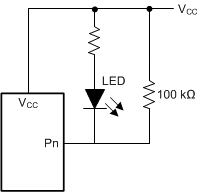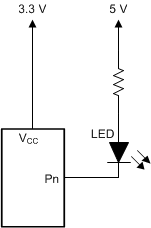SCPS279 February 2022 TCA9537
PRODUCTION DATA
- 1 Features
- 2 Applications
- 3 Description
- 4 Revision History
- 5 Pin Configuration and Functions
- 6 Specifications
- 7 Parameter Measurement Information
- 8 Detailed Description
- 9 Application Information Disclaimer
- 10Power Supply Recommendations
- 11Layout
- 12Device and Documentation Support
- 13Mechanical, Packaging, and Orderable Information
Package Options
Mechanical Data (Package|Pins)
- DGS|10
Thermal pad, mechanical data (Package|Pins)
Orderable Information
9.2.1.1 Minimizing ICC When I/Os Control LEDs
When the I/Os are used to control LEDs, they are normally connected to VCC through a resistor as shown in Section 9.2. The LED acts as a diode so, when the LED is off, the I/O VIN is about 1.2 V less than VCC. The supply current, ICC, increases as VIN becomes lower than VCC.
Designs needing to minimize current consumption, such as battery power applications, should consider maintaining the I/O pins greater than or equal to VCC when the LED is off. Figure 9-2 shows a high-value resistor in parallel with the LED. Figure 9-3 shows VCC less than the LED supply voltage by at least 1.2 V. Both of these methods maintain the I/O VIN at or above VCC and prevent additional supply-current consumption when the LED is off.
 Figure 9-2 High-Value Resistor in Parallel with the LED
Figure 9-2 High-Value Resistor in Parallel with the LED Figure 9-3 Device Supplied by a Lower Voltage
Figure 9-3 Device Supplied by a Lower Voltage